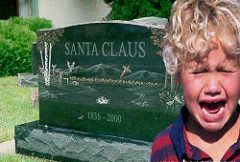kw988411@ohio.edu
Better photoshop technology and wide-set access to this technology has made the altering of photos a problem among both journalists and pedestrians. One such recent example is a photo submitted to Poynter Online's gallery of "Awkward Tombstones." The photo shows a little boy crying in front of Santa Clause's tombstone. In his article, "Altered Photo a Reminder of Issues with User-Generated Content," Steve Meyers explains that the image of the little boy is actually a stock image that the individual pasted onto a picture of Santa's tomb.
 |
| Photo-shopped image on https://www.flickr.com/photos/jurvetson/449483 |
The problem with this image is that it was submitted under the false pretext that it depicts a truthful moment: a moment that actually happened. And journalists are supposed to report moments that actually happen...
The person who submitted the photo is a pedestrian, of course. Many journalists have expressed concerns with user-generated content because of instances like these. Pedestrians who submit material to news organizations are not trained in ethical decision-making as most journalists are. In addition, these individuals' careers do not depend on conducting themselves with honesty and integrity. They don't have the repercussion of losing their whole career... so what do they really have to lose, anyway? Other than looking really stupid...
The individuals who submit user-generated content also may not understand the seriousness of tampering with a photo. I personally didn't understand the big deal with a journalist editing or tampering with a photo - as long as the alteration doesn't completely distort the story - until I began my education in the journalism school here at Scripps.
My original education is in the theatre world. A theatre artist's job is to tell a compelling story, and the integrity of an actor's work doesn't rely on objectivity or accuracy, but on imagination and originality.
The Santa tombstone picture is certainly creative.
But it's not truthful.
The theatre artist must go big or go home. In contrast, the journalist must go real or go home.
Cara Richardson, an editor for USA Today and Scripps Journalism school alum, told our Fundamentals of Online Journalism class that she stays away from numbers when Tweeting live news. Her first Tweet about the terrorist attacks in Paris didn't include the number of dead. And there's a good reason for it.
Richardson waits to put a number out there before she can verify it's accuracy. Better to broadcast the number late than to give false information to the public.
Accuracy is everything in journalism, and this rule applies to photos. In his article, "How journalists verify user-generated content, information on social media," Craig Silverman cites the AP's definition of an accurate, journalistic photo in their code of ethics: "No element should be digitally added or subtracted from any photograph. The faces or identities of individuals must not be obscured by Photoshop or any other editing tool. Minor adjustments in Photoshop are acceptable. These include cropping, dodging and burning, conversion into grayscale, and normal toning and color adjustments that should be limited to those minimally necessary for clear and accurate reproduction."
Journalists today aspire to a high standard of accuracy. But it wasn't always this way...
In Craig Silverman's introduction to "A New Age of Truth," Silverman shares quotes from an old journalistic handbook, in which the author, Edward L. Shuman, actually encourages aspiring journalists to make up details to create a more compelling story. In his 1894 guide Steps Into Journalism, Shuman states, "Truth in essentials, imagination in nonessentials, is considered a legitimate rule of action in every office...The paramount object is to make an interesting story."
Imaginative story-telling and altered images are a fun and worth-while means of creative expression that utilize today's technology. Check out this artist who photo-shops her fat cat into famous works of art:
 |
| http://twistedsifter.com/2014/06/artist-photoshops-fat-cat-into-famous-artworks |
 |
| http://twistedsifter.com/2014/06/artist-photoshops-fat-cat-into-famous-artworks/ |
No comments:
Post a Comment